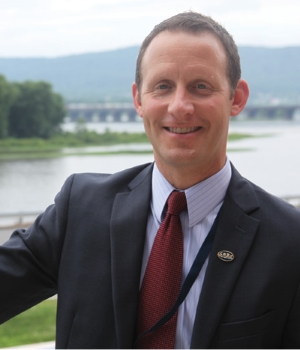Executive Director's Message
Fall 2025: Hydropower Relicensing, A Once-in-a-Career Opportunity

We preach it, you’ve heard it – what happens upstream impacts conditions downstream. This could not be more true than when it comes to dams, which can alter water flow, trap sediment, block fish migration, change natural flood cycles and more.
Two hydroelectric dams on the lower Susquehanna River, Safe Harbor and Holtwood between York and Lancaster Counties, are currently up for federal license renewal. Having a say in the relicensing is a once-in-a-career opportunity as the Federal Energy Regulatory Commission (FERC) licenses hydropower for a term of 30 to 50 years.
Our Commission founders were visionary in creating a lengthy 100-year compact as they saw not only the long-term need to protect the resources of the basin, but also that someone representing all 27,510 square miles of the basin needed to be in place when license renewal time came around. Remember, upstream affects downstream. And the effects don’t care about human-drawn lines, blindly flowing past state borders.
In the early 1900s, dam creators chose the Susquehanna River due to its reasonably substantial flow rate. But it’s unlikely they were concerned with or anticipated the shifting weather extremes of the future. Even with precipitation rates predicted to increase throughout the century, intense droughts are also expected. It is perhaps apt timing that our involvement in the relicensing is beginning as we navigate the low flow season. Our compact directs us to ensure adequate flows to the Chesapeake Bay – largely done through our water withdrawal regulations, drought coordination and comprehensive planning . Having a voice in FERC’s dam licensing is crucial to protect those flows.
We recently submitted comments on pre-application documents for both Safe Harbor and Holtwood. Safe Harbor has not gone through the FERC process since 1980, and it has been more than 20 years since Holtwood had a license amended. Needless to say, much has changed both upstream and downstream.
As part of the relicensing process, the Commission and our partner agencies are requesting multiple studies on environmental flow, fish passage, water quality, lake level management, recreation access and debris management. Results of these studies are vital to manage the dams in a manner that lessens future impacts and better balances the competing flow needs related to aquatic resources, power generation, public water supplies, downstream users, and inflow to the Chesapeake Bay.
If and once a license is granted, it will remain in effect for up to 50 years. An objective and contemporary science-based evaluation of both past and potential long-term future impacts must be completed now. I started my career here at SRBC as an intern more than 30 years ago. A chance to help get this done right won’t come along again in my career or for many I work alongside, so we can’t afford to let it simply flow by.
Best regards,
Andrew D. Dehoff, P.E.
Executive Director